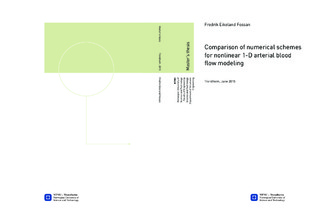| dc.description.abstract | In this Thesis, the numerical methods used in STARFiSh (MacCormack or McC) have been tested and compared with five other state of the art flow-solvers: discontinuous Galerkin (DCG), locally conservative Galerkin (LCG), Galerkin least-squares finite element method (FEM), finite volume method (FVM), and a simplified trapezium rule method (STM). Comparisons are made in a series of six benchmark test cases with an increasing degree of complexity. The tests revealed limitations in the original implementation of STARFiSh. The original MacCormack scheme was not implemented correctly, which resulted in discontinuities between boundary and field nodes. The scheme also proved to be non-conservative in cases with big relative weight on the convective term. The original linear bifurcation model gave rise to discrepancies in networks with big changes in dynamic pressure. As a result a new conservative solving scheme, and a new bifurcation model was implemented. The implementations have been validated in the comparison with the five other flow solvers, and in additional cases where analytical solutions exist.
The thesis has evolved around a joint project to form the article "Comparison1D-scheme". The tests, results and findings have been conducted to contribute with STARFiSh's part of the article. The accuracy of the numerical schemes is assessed by comparison against theoretical results, 3-D data in compatible domains with distensible walls, or experimental data in a network of silicone tubes. Results show a good agreement among all numerical schemes
and their ability to capture the main features of pressure, flow and area waveforms
in large arteries.
Grid tests show that for the physiological cases where the wave length is long comparing with each vessel segment, low CFL numbers can be tolerated without introduction of significant diffusive and dispersive errors for STARFiSh solutions.
A model which integrates Womersley theory for pulsatile pipe flow with One-dimensional (1-D) compliant vessel flow, have been established. The solutions using Womersley theory for estimating the velocity profile, and it's subsequent effect on convective- and friction term have been compared with solutions using an assumed velocity profile. The solution using Womersley theory did not yield better results comparing with 3-D numerical data, in a single vessel test replicating blood flow in the upper thoracic aorta. | |

